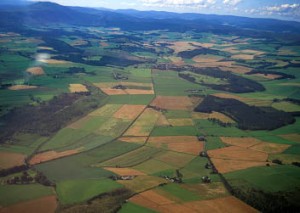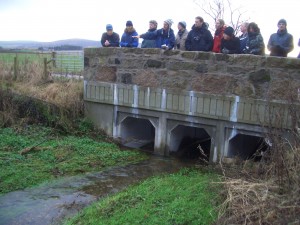An introduction to our work in the Tarland catchment
Map of Talking points | Previous Slide | Introduction | The Tarland burn, tributary of the Dee
An audio file (WAV format) of the above below is An introduction to our work in the Tarland catchment.
 The Macaulay Land Use Research Institute, now The James Hutton Institute, has worked in the Tarland catchment since the late 1990s. Two things framed the Tarland Catchment initiative as it was initially called.
The Macaulay Land Use Research Institute, now The James Hutton Institute, has worked in the Tarland catchment since the late 1990s. Two things framed the Tarland Catchment initiative as it was initially called.
Firstly, in the late 1990s, funds were provided by the Natural Environment Research Council for a project titled ‘Large Scale Processes in Ecology and Hydrology’.
This focussed on factors affecting the water quality of the River Dee here in North-east Scotland, of which the Tarland burn is a tributary.
The first peer review results showed that the water quality and water quantity are very strongly linked, and that the western part of the Dee catchment produces a lot of high quality water which dilutes what comes in from downstream tributaries.
As you move down the catchment the first signal of nutrients coming into the Dee is from the Tarland Burn – you can see a spike in nitrates and sediments, and occasionally in phosphorus (which is harder to model because it is driven by unpredictable events).
 So, if you take a whole systems approach, with the Dee as your system, then the uppermost sub-catchment where you might be able to do something to affect the Dee, the principle hotspot for land-managers and other stakeholders, is Tarland. So here we’re not talking about things like climate change or acidification which may be issues further upstream. So what are the issues? Well it’s all about river functioning, so we’re talking about water quality, we’re talking about flooding, how to alleviate flooding, we’re talking about good ecological status.
So, if you take a whole systems approach, with the Dee as your system, then the uppermost sub-catchment where you might be able to do something to affect the Dee, the principle hotspot for land-managers and other stakeholders, is Tarland. So here we’re not talking about things like climate change or acidification which may be issues further upstream. So what are the issues? Well it’s all about river functioning, so we’re talking about water quality, we’re talking about flooding, how to alleviate flooding, we’re talking about good ecological status.
The idea is that once the Tarland is understood you can start to work your way down the Dee because a lot of the issues are in common, and indeed land use maps show that there’s increasing intensification of land management as you move eastwards towards Aberdeen.
Category: Background, Tarland catchment management aims







